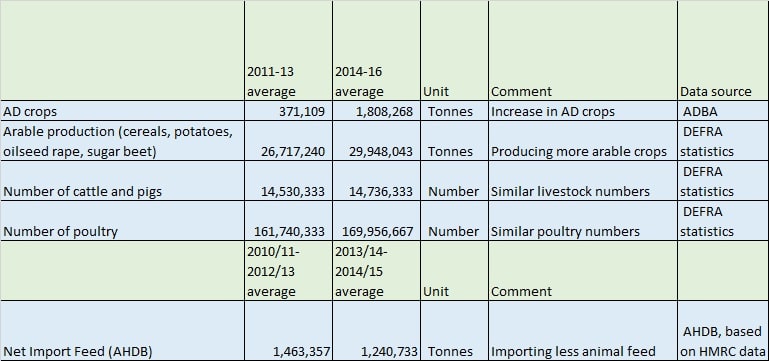The International Energy Agency recently issued its second Outlook for Biogas and Biomethane. It concluded…
ADBA analysis – AD crops little impact on UK food output
We've long argued that using crops for AD in reasonable amounts is a good thing. It diversifies farm incomes, allows the profitable introduction of longer crop rotations, reduces emissions and stores carbon in soils.
ADBA has analysed data produced by the Agricultural and Horticultural Development Board and by DEFRA to establish the impact of AD crops on UK food production since 2011, when crops used for AD really started to take off. These indicate that crop AD is having little impact. We have previously shown in our Market Reports that the amount of land used for AD crops is very low (e.g. less than that used for golf courses), so it is no surprise that using crops for AD to date has had little visible impact on food production. A DEFRA-funded study in 2015 found that, in regard to land rental values, “Spatial modelling of land rental values found no significant influence of proximity to AD plants”, which is one metric of measuring impact.
The following table comparing agricultural outputs before crops were widely grown for AD and the last three years, shows that the increase in AD crops does not appear to have had a significant impact on animal feed or human food outputs:

What we can draw from this is that growing crops for AD appears to be not yet at a scale to impact on food production. Use of crops for AD also has many benefits for the growing of food crops, as they help support food crop yields.
As outlined in the AD industry's Case for Crop Feedstocks in AD, the industry's ambition of 1,000 farm AD plants would use something like 220-235 k hectares of land (~1.3% of UK agricultural land). Currently we have about 284 agricultural AD plants and are approximately one third of the way towards the ambition, although the potential for use of more manures is still huge. Rather than the government imposing limits on the amount of crops each new AD plant can use (as it proposes for the Renewable Heat Incentive and Feed-In Tariff), the government should be undertaking an analysis of the agriculture industry and food production and considering what its ambition is for farm AD and AD more generally.
Climate change is having a significant impact on food and hunger across the globe, so using ~1.3% of UK agricultural land to reduce emissions is reasonable. The United Nations provides the following table showing that 25 million more children risk hunger in the coming years compared to no climate change:

We continue to outline the benefits of farm AD to farming, including the use of crops – I'll be speaking on this at our National Conference next Thursday on a panel with the National Farmers' Union, an agricultural AD operator and a small scale AD developer.

